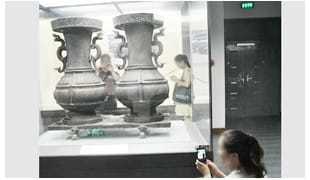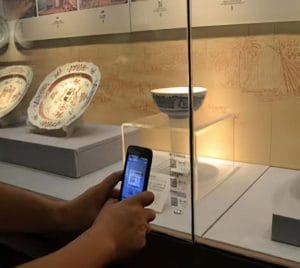Every time I visit a museum or scenic spot, I inevitably encounter some minor disappointments: When traveling in a group, the tour guide moves too fast. Just as I start to be interested in a piece of cultural relic, I have to follow the large group and move forward; If I want to rent a traditional guidebook, I have to queue up and pay a deposit, and then I have to go back to return it. If I lose it, it will be even more troublesome; When meeting foreign friends asking for directions, I want to recommend the story of the scenic spot, but due to language barriers, I can only wave my hand… Until last month at the Palace Museum, I happened to see an elderly woman with white hair smiling at the blue QR code beside the display cabinet. She was holding a mobile phone, not wearing headphones but still able to clearly hear the gentle explanation. Her grandson who was nearby came over and asked, “Grandma, is this about the story of the dragon throne?” The woman nodded and said, “Look, there are also pictures here.” Later, I learned that this was the QR code automatic tour system. From that day on, I unlocked a new way of freely exploring the exhibition.
No need to queue, just scan the QR code to start the guided tour
That day, beside the museum, I noticed that there was a QR code printed at the bottom right corner of the display board, accompanied by a small note: “Scan to listen to the explanation, support multiple languages”. Out of curiosity, I opened the “Scan” function on WeChat – no complicated links were opened, nor was an APP needed. After a few seconds, I entered a simple page: in the middle was the “Start Explanation” button, below which were three options: “Chinese”, “English”, and “Japanese”, as well as two small icons: “High-definition Gallery” and “Related Stories”.
I clicked on “Chinese Explanation”, and immediately a clear voice of the announcer came from the phone. The voice was not harsh, and the speaking speed was moderate. Even in a crowded exhibition hall, lowering the volume would still allow one to hear clearly. What’s more considerate is that the explanation was segmented. After each point was explained, there would be a two-second pause. If one didn’t understand, they could rewind the video to replay it, without having to listen from the beginning again.
Later I learned that the Yingmi T1 was specially designed for tourists – whether using WeChat, QQ, or the scanning function in 360 Security Guard, it can be easily recognized; even for the elderly who are not very proficient with smartphones, as long as someone helps scan it once, then clicking “Start Explanation” will do. There are no unnecessary buttons on the interface, which won’t make things confusing.

From Sound to Immersive Experience, Bringing Cultural Relics to Life
Professional and flexible explanatory content
Last week, I visited the Terracotta Army Museum in Xi’an. I scanned the QR code beside Pit No. 1. Besides the usual “Background of the Terracotta Army Pit Construction” explanation, a “AR Experience” button popped up at the bottom of the page – when I clicked it, by scanning the terracotta figurines inside the pit with my phone, a virtual artisan appeared on the screen: He was squatting beside the figurine, step by step demonstrating how to shape, apply glaze, and fire it. Even the details of how the colorful patterns on the figurines were preserved were clearly visible on the phone screen.
Multimedia and Interactive Experiences
Next to her, a girl who looked like a college student was also playing AR. She told me, “Before, just seeing the Terracotta Army made me feel awe-inspiring, but I didn’t know how they were made. Now, watching this AR animation, it feels like I’ve traveled to the workshop of the Qin Dynasty. It’s much more vivid than what’s described in the textbooks.” What’s even more interesting is that after the AR demonstration, the system popped up an “AI Q&A” box. A few seconds later, it received a professional reply. Later, I learned that the content of the QR code automatic tour system is not fixed. The museum staff said that they will update the explanations based on the latest archaeological discoveries. For example, if there are new research results for a certain mural in the Mogao Caves, there’s no need to re-make the exhibition signs. Just modify the content of the QR code automatic tour system online, and tourists will hear the new explanations when they scan the QR code next time.
Comparison: What makes the Yingmi QR code automatic tour system T1 better than the traditional guided tour experience?
After using the Yingmi QR code automatic tour system T1 several times, I deliberately compared it with the previous “traditional guided tour experience” and found that it solved many of the problems that tourists had.
Firstly, it’s more flexible. When visiting scenic spots in a tour group, the tour guide would set “stay at this scenic spot for 15 minutes” and “gather at the next scenic spot”. If you encounter a place you like and want to stay longer, it’s impossible. But when using T1, I can follow my own pace completely – beside the Broken Bridge in the West Lake, after listening to the legend of “Bai Mo Zhen and Xu Xian”, I clicked on “Related Stories” and learned the origin of the name of the Broken Bridge, and also viewed photos of the Broken Bridge in different seasons. I stayed there for 40 minutes, and no one reminded me or hurried me. Mr. Wang, who brought his grandson to visit, said: “I have slow legs. Before, when I was in a tour group, I couldn’t keep up. Now with this QR code scanning explanation, when I get tired from walking, I can find a chair to sit down and listen. After listening, I continue walking. It’s much more comfortable.”
Secondly, it’s more convenient. Traditional audio guided tour devices require renting and paying a deposit, and sometimes you have to queue up. If you forget to return it, you have to go back to the scenic area service center. But Yingmi T1 doesn’t have these – just carry your own phone. After listening to one scenic spot, when you go to the next one, you just scan the next QR code. You don’t have to worry about “returning the equipment”. Moreover, since the phone is your own, the sound quality and volume are in line with your own habits, which is much more comfortable than using an unfamiliar guided device. “Last time I rented a guided device, I paid a deposit of 200 yuan. When I returned it, I queued up for 20 minutes. Later, I found that I could use T1 with my phone, and I never rented a device again,” a tourist told me with a joke.
Also, it’s more hygienic. After the pandemic, everyone was very concerned about the hygiene of public items. Traditional guided devices were used by many people every day, even if they were disinfected, there was still some concern. But Yingmi T1 uses your own phone, no contact with others’ things, clean and reassuring. “When I take my child out, I’m very afraid that he will touch public items. Now with my own phone for listening to the explanation, I don’t need to remind him ‘Don’t touch’, it’s much more convenient.” A mother said.
For scenic spots and museums, the Yingmi T1 also has many advantages. The staff at the Palace Museum told me that previously, the scenic spots needed to employ many tour guides, which was costly. During peak tourist seasons, there would be a shortage of guides. Now with the T1, not only has the labor cost been reduced, but it has also enabled more tourists to receive professional explanations. Moreover, through the backend data, they can know which exhibits have received more scans and which ones have attracted longer stays by visitors.

Details: Thoughtful Small Design
High error tolerance rate
Once in an outdoor scenic area, the QR code was slightly damp by the rain, and the edges were a bit blurry. I thought I couldn’t scan it, but when I opened WeChat and scanned it, it worked successfully. Later, I asked the staff and learned that the QR code of T1 has a tolerance rate of 30%. Even if there is some wear and tear, stains, or direct sunlight exposure, it can still be easily recognized, without needing to
“find the angle”for the QR code. “Last time I scanned under the shade of a tree, at first it didn’t work, I thought the QR code was broken. But when I changed the direction, I was able to scan it. It turns out you don’t need to specifically look for a bright place.” A tourist shared with me.
Content segmentation
The explanation of T1 is not listened to in one continuous segment, but is divided into “basic introduction”, “in-depth story”, and “fun facts” sections. Tourists can choose to listen based on their own interests. For example, when looking at blue and white porcelain in a museum, if you only want to know “which dynasty it belongs to”, listen to “basic introduction”; if you want to know “its firing process”, click “in-depth story”; if you bring your children, you can also listen to “fun facts”, such as “what did the ancients use the blue and white porcelain for”, and the children were particularly fascinated.
Offline listening
If the signal in the scenic area is poor or you don’t want to use data, tourists can scan the QR code in a place with internet connection to cache the explanation content, and then listen when there is no signal. “Last time I went to a mountain village in the mountains, the signal was extremely poor. I cached the explanation of T1 in advance, and during the visit, it didn’t cause any delay, which was much more reliable than using data.” A tourist who likes to visit small and less-known scenic spots said.
Conclusion: Make “visiting exhibitions” into “understanding exhibitions”, this is the meaning of travel
Now every time I go to a museum or scenic area, I will first look for the Yingmi T1 QR code beside the exhibition sign – unlike traditional tour guides who “push you along”, or like the navigator app that “puts a burden on you”, it is more like a “friend who understands you”, accompanying you to wander and listen, allowing every scenic spot and every artifact to “speak”.
Remember in the Mogao Caves of Dunhuang, I scanned a “Flying Heaven” mural, listened to the explanation, and then watched the high-definition image collection and AR animation. Suddenly, I understood why the ancients would draw “Flying Heaven” so beautifully – those ribbons were not drawn casually, every line contained the meaning of “freedom”. At that moment, I was no longer a “skimming through” tourist, but truly walked into history and understood the story behind the artifacts.
If you are tired of the hurriedness of group tours, or think it’s troublesome to rent a navigator app, the next time you go to a museum or scenic area, don’t forget to pay attention to the Yingmi T1 QR code beside the exhibition sign – no deposit, no queue, just carry your phone and scan, making every trip “able to understand, remember, and gain something”. After all, the meaning of travel is never “having been there”, but “having understood” – and the Yingmi T1 is helping us achieve this “understanding”.